Outdoor Free time Play Nature Forest Woods
Tinkering in the trees
Technology and organized structuring of “free time” has a tremendous impact on why children are indoors more than outdoors, but the benefits of being outside playing in nature have scientifically proven positive impacts on health, the immune system and children’s development.
Reports of emotional and sensory disorders in children are on the rise, as are attention disorders. Kids are actually physically weaker than they were 25 years ago, not to mention heavier too *.
Angela J. Hanscom has an answer for us in her book, Balanced and Barefoot. She proposes that our children’s increased levels of attention disorders, obesity, poor physical capabilities, heightened emotional sensitivity, and anxieties can all be solved with one simple lifestyle change.
As adults, we need to support children in learning to enjoy what free play in the outdoors has to offer. We need to inspire imaginations, creative minds, and capable bodies. To do this, we can look toward two simple things: nature and adventure.Children who do not have access to outdoor play will miss out on the many benefits that free play in the natural environment has to offer toward their growth.
My Whole Family Enjoys Time Outside
From the moment that my family and I head outside into a natural setting, everything seems to change. And in a GOOD way. We slow down, we laugh more, and we have time to just "be" together — 100% family bonding without any type of distractions.
And honestly, when we are outdoors together, it doesn't seem to matter what we are doing. Taking a walk, bird-watching or digging in the dirt pulling up some weeds in the garden...everything becomes exciting and an adventure.
5 Reasons Nature is The Best Place to Escape "Busy" And Connect With Your Kids
Nature has a way of bringing families together. The birds chirping, the cool breeze blowing across your face and the beautiful greenery of the Earth growing in every direction all around have a magical way of fostering a great bonding environment for your family. Instead of saying "no" to outdoor time, say "yes." There are so many benefits to getting outside together as a family!
It's a safe place for your entire family. Stepping outdoors can feel that a sanctuary that your whole family belongs to.
Nature promotes a way for you and your family to exercise your body and mind. Every time that you are in nature, you are learning something new and also exercising your body. Nature is indeed a powerhouse when it comes to caring for the health of you and your family!
The beauty of nature sparks beautiful conversations. Sunsets, vibrant flowers, animal sightings...all those events create topics of conversation to have with your family.
When in nature, time seems to slow down and stand still. Being in nature means that the clock doesn't matter. If you and your family want to spend the day exploring every nook and cranny in your backyard, at the neighborhood park or a campground 150 miles away, go with that feeling and need!
Getting back to nature is the key to re-programming our families. No matter what you're in the mood for, nature always has a plan and activity waiting.
Enjoy the outdoor adventure, friend.

It’s time to step away from screens and send your kids outside to play, here’s why:
1. Obesity is surely the most visible sign of a sedentary lifestyle spent mostly inside, but other symptoms include attention deficit hyperactivity disorder (ADHD), stifled imagination and creativity, and reduced ability to problem solve and show self-discipline.These can be significantly improved when children spend more time moving and playing outside.
2. Being in a “green” environment has been shown to improve overall wellbeing, self-esteem, bring immediate stress relief, spurs creativity and even significantly improve learning and recall ability, and mental and emotional wellbeing. (Source: University of Essex research study).
3. Unstructured free play outside promotes creativity and imagination because children can immerse themselves in an environment, and think and play freely without adult agendas. When children head outdoors, they are naturally curious about their environment and new surroundings – the childlike wonder we swoon over as parents, suddenly reappears!
4. Being outside may feel less like a stimulating environment than a learning activity, or even playing a video game, but being immersed in nature forces children to engage their senses. When kids are outside, they see, touch, smell, and hear what’s around them but when they are mostly indoors, children can’t engage these senses properly and over time, they become dulled and function diminishes.
5. Exercise helps kids focus, and improve recognition and recall abilities.
While exercise doesn’t have to be a team sport or turn you into a weekend warrior at the soccer fields, heading outside to get your blood pumping and breathe in fresh air is beneficial for every age.
Walking the dog, going on a bike ride or playing hopscotch outside is better than being a couch potato watching a screen.
6. According to the Attention Restoration Theory, in a natural environment, we practice an effortless style of attention called “soft fascination.” which creates feelings of pleasure and restfulness.
However, when you live in an urban environment you use what’s called “directed attention,” which forces a person to ignore distractions and exhausts the brain.
Being in nature is the opposite of this – immersing yourself in a green and natural environment – reduces stress and brain fatigue, decreases aggression and increases overall happiness.
As one study published by the American Medical Association in 2005 states, “Children will be smarter, better able to get along with others, healthier and happier when they have regular opportunities for free and unstructured play in the out-of-doors.”
The Importance of Free Play
When children are engaged in free play in the outdoors, they are provided opportunities for freedom, choice, and fewer routines. In free play, there is no adult direction or control, so children can play how they want to play. When children are given such freedom to play, they are more likely to engage in higher levels of social interaction, cognitive skills such as decision-making and reasoning, empathy, and physical activity. In turn, they are less likely to become inattentive, anxious, or depressed and unhealthy.
The outdoor environment has many benefits. A natural green space allows children to continuously explore ways to use materials, discover the varied environment, and create their own play experiences. The outdoor environment is not a man-made area and, therefore, is diverse and timeless. Children who play outdoors have heightened senses and emotions from the ever-changing topography and the rich stimuli that a natural space affords. This is how children learn – through experience: by seeing, feeling, touching, and hearing. The outdoor environment is a blank canvas on which children are able to place their own thoughts, wonders, and creations.
If they are of an age that they can play independantly, free or unstructured outdoor play should comprise fifty percent of their freetime.
They should be allowed the freedom to unwind at the speed they want to and talk as loud as they want. You have chosen the time, their provisions, and the place for them to unwind. Let them cut loose outside an they will enjoy their outdoor time. You will learn what interests them, and that insight will allow you to create and look for provisions that they will enjoy doing outside.
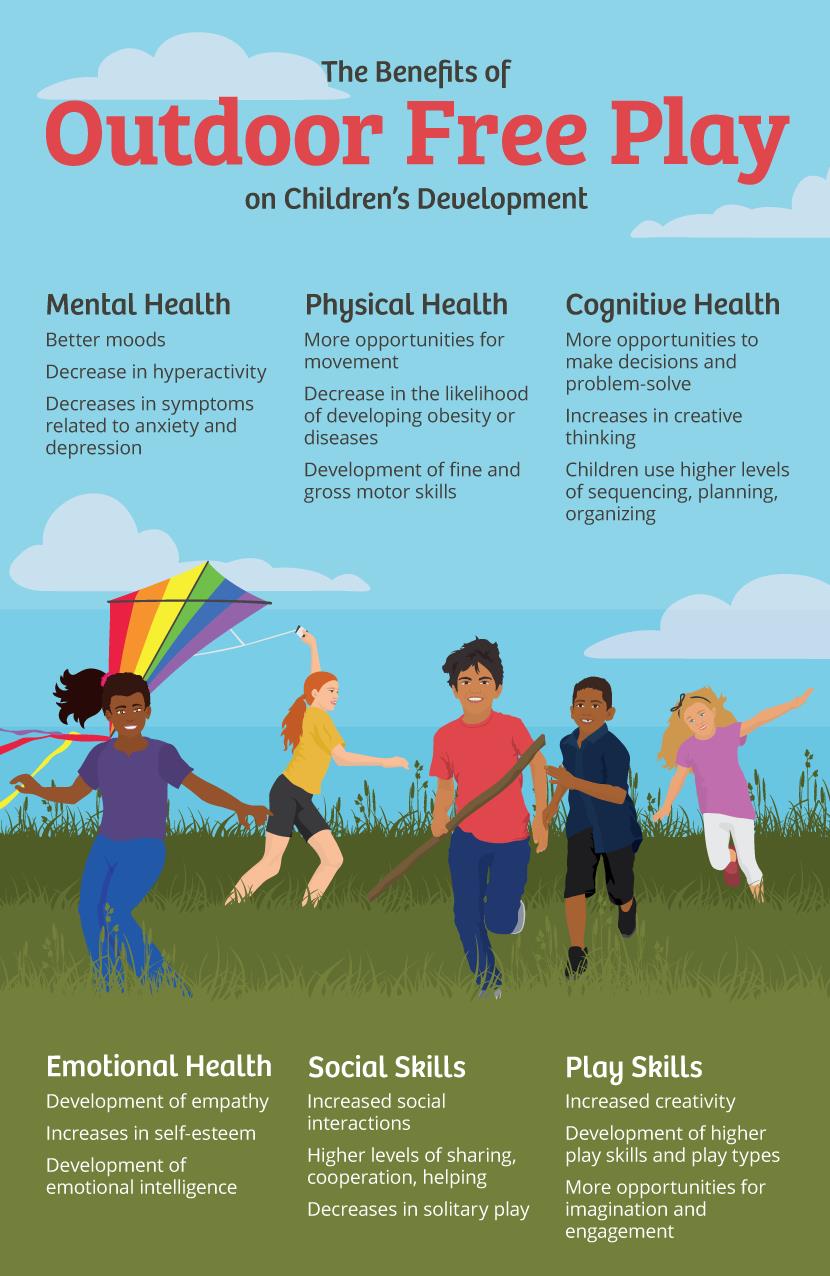
So what can be done now? After this discussion of the importance of free play in the outdoors you may be wondering how you can bring back play for children in your life. There are two things to support you in doing so: nature and adventure. What you are going to need to do is reintroduce adventure back into children’s outdoor play.
4 Ways to Inspire Kids to go outside
and be active
My kids favourite outdoor activity is climbing trees. It’s the first thing they do when they get home from school and I love that it attracts them more than any other activity. It is important to me that my kids get independent playtime outside, but sometimes kids won’t go outside without a little push from an adult. Here are some simple ideas if your kids need a little encouragement.
1. Gear Up
Make sports equipment easily accessible so you’ll be more likely to use it. Park bicycles near the front of your garage, or keep scooters in the mudroom to inspire impromptu usage. Stash a Frisbee or soccer ball in your car for pick-up games, or “catch up” on the day while playing a quick game of catch in the evenings. The idea is to integrate activity into your everyday life so it becomes a part of your routine.
I love the advice about integrating it into everyday life. We use scooters to go to school everyday, often stop at the pond near school to explore the changing seasons and have skipping ropes near the door so they are easy to grab.
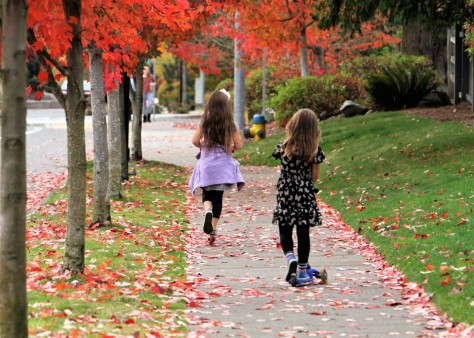
2. Play Nature Bingo
Which family member has an eagle eye for spotting things like squirrels, ant hills or pine cones? To find out, head to your local park—or simply your own backyard—and play an active yet educational game of Nature Bingo. Print out a free online template (we like these for their earthy feel) and try to find as many items as you can, marking off each square as you go.
Nature bingo is always fun. When my girls were younger and struggled to walk back from the park, I would pretend we were pirates and give them a list of “treasures” they had to find or collect .You can also try some of these woodland activities we enjoyed. They would work equally well in a garden or park.
3. Embrace Old School Games
When we were kids, it was all about classic backyard games like Freeze Tag, Simon Says and Hide-and-Seek. Our favorite? Red Light/Green Light. One child acts as the “stoplight” and stands with his or her back to the crowd across the yard from the other kids. When the stoplight shouts “green light,” the kids move forward and try to be the first to touch the stoplight. At any point, the stoplight may shout “red light!” and turn around. If any of the players are caught moving, they’re out.
Regular readers will know, I think it is really important to teach my kids games from my childhood and other simple games. It will not only preserve these games and rhymes for future generations but it is also an opportunity to play together outside. I recently taught them how to play elastics (French skipping) and we had great fun.
Try out some of my families favourites here.
4. Go Exploring-Take a Walk
It sounds so simple, but sometimes it’s nice to get back to basics with regular family walks. Take the dog out together in the morning instead of making it a one-man job. Or work off dinner by hitting the pavement as a family for a sunset stroll. It’s a great way to discover your surroundings, get to know your neighbors, and enjoy quality time as a family while burning off energy. When my youngest was small she hated to walk but loved to see things in our neighbourhood. I bought her a scooter and she used that and never complained.
Before my youngest started school, she would ask me everyday if we could go for a walk. She loved to discover things you can only find on foot. We identified flowers and plants, rescued worms and snails, found caterpillars, fed the ducklings, birds, frogs and salamanders, picked blossoms, caught leaves and often carried a snack or ice/water for the animals. Living on Mount Falcon, was a such a great place to grow up.
What are your favourite ways of getting outside?
Hope always asked to go exploring when she wanted to enjoy the weather or check out what the animals were doing. Now if she asked to find some treasures, she wanted art or building supplies.
So maybe using enticing phrases would help a more hesitant child.
Suggestions to get your kids comfortable in the woods
The woods are not just for a hiking destination they are full of oxegen rich air, sunshine and adventure.
Here's some ideas for free activities you can enjoy in your local woods. It is essential that your kids feel excited to explore nature when they are out there, So let's make the most of family time there as well!

1. Climb a tree or a stump.
Be careful to respect Mother Nature and don't damage the bark. Climbing up high gives kids a whole new perspective, it builds confidence and agility skills, is great physical exercise, and let's face it is a fundamental part of being a kid. The Forestry Commission actively encourage children to climb - so you won't get told off!
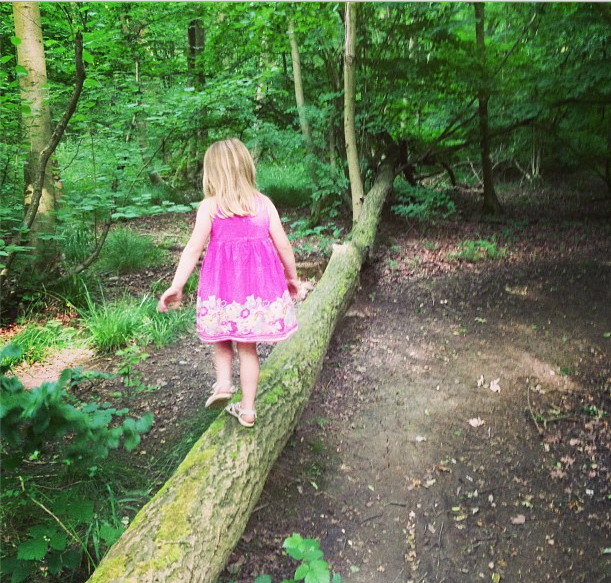
2. Practice balancing skills
.Find a fallen tree and pretend you're walking the plank; balancing on the high beam or walking a tightrope. Have competitions to see who can get the furthest. Hold hands for younger children for safety, but still allow them a sense of achievement.
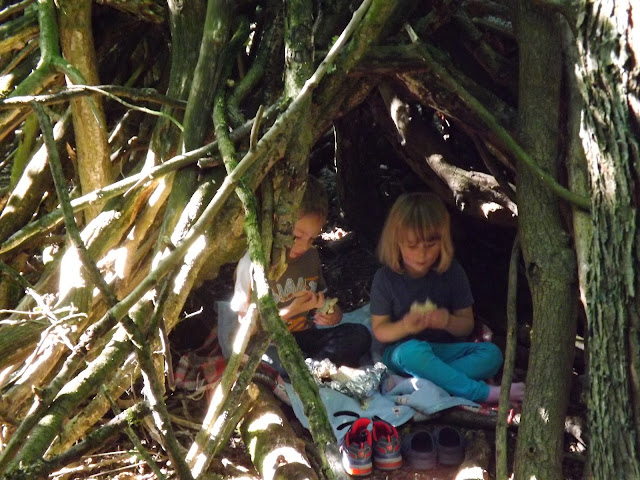
3. Build a Stick Fort or Hideaway
Great for team work. Get the whole family involved and check out these great tips from the experts for how to do it safely and effectively. Failing that, find one that's already built and squat! Take some old blankets and cuddly toys and snuggle down.
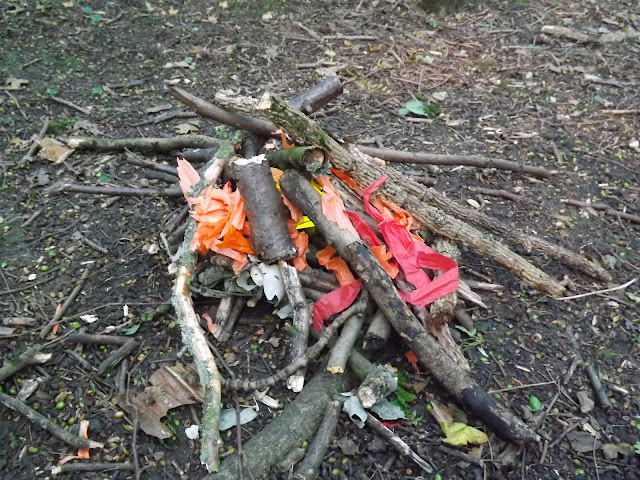
4. Make a 'pretend campfire'.
With this heatwave we've been having, the ground and vegetation is tinder-dry so take extra care with naked flames. Real fire lighting is something best left to the experts, following strict safety precautions, but older children may be interested to find out how it's done by attending a bushcraft day - check the Forestry Commission's website to find workshops near you such as this one at
. For younger children, it's fun to collect sticks and twigs and pile them up into a pretend fire. They can play and rubbing sticks together boy-scout style. Take some red and orange tissue paper along with you to make realistic looking make-believe flames (remember to take all litter home with you).

5. Forest words and art.
Just because school's out, doesn't mean you should forget about reading and writing! Gather up sticks to spell out woodland-themed words. Or collect up leaves, seeds; pine cones and feathers to make a giant picture on the ground.
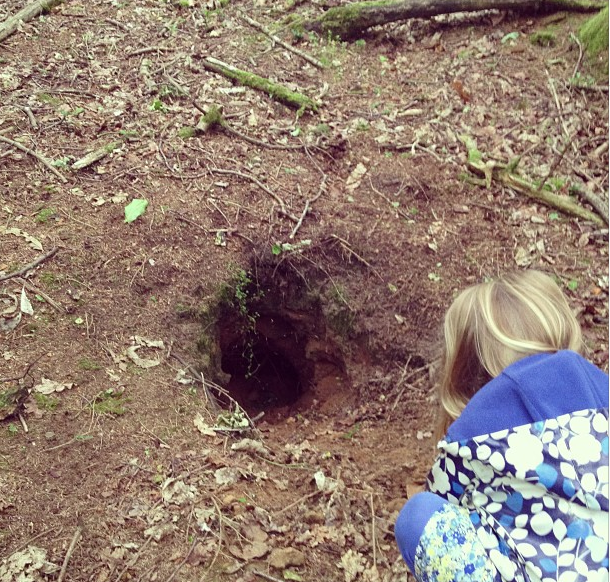
6. Wildlife exploration.
The forest is full of creatures great and small, see how many you can find. From beetles to butterflies to birds to badgers. Look for clues such as nibbled nut shells; footprints; trampled undergrowth and burrows. Sketch or take photographs so you can research them back at home and discover what animals might have been there. If you're organised you could take some
plaster of paris with you to make a cast of any footprints you find.
7. Take some books to read.
There is nothing more peaceful than reading a favourite story under the shade of a big tree. Find a comfy spot, maybe on a soft mossy bank, cuddle up and see how well loved tales come to life in the woodland environment. Maybe you'll read the Gruffalo, or Going on a Bear Hunt, or one of the Grimm's fairy stories. See how it inspires play and transforms your surroundings. The Forestry Commission have a fabulous new Fairy Tale initiative running, with free downloads, ideas and inspiration and details of special 'fairy tale installations' at some sites.

8. Collect natural art materials.
Whether it's sticks, stones, leaves or feathers, nature provides a wonderful bounty for crafting when you get back home. Maybe you could make stick men; decorate stones to make fairy houses; make a
willow wreath or bark candle holder

9. Borrow some educational books from the library.
Borrow books for free, and learn to identify wild flowers, different types of trees and seeds. Over the summer libraries are running a reading challenge, so these books will all count towards them. We love the I-Spy books. You could even set a challenge or treasure hunt to see who can find the most varieties of leaves for example.
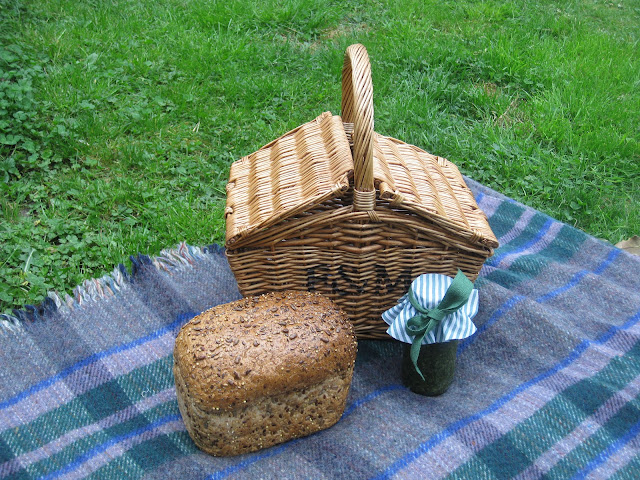
10. Take a picnic.
Some larger forests have cafes on site, but if not pack up a picnic and plenty of cool drinks. Keeping the kids fed and watered means they'll want to stay even longer! Remember to be respectful and take your litter home or use bins provided.
